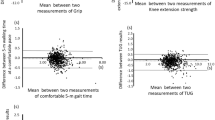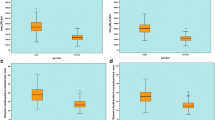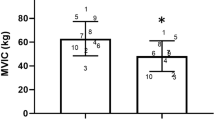Abstract
The relationship between strength, fatigue, and work capacity is a central issue for occupational rehabilitation. Musculoskeletal impairments often are expressed functionally as a loss of strength. For work tasks that require strength, such impairments may have a detrimental effect on work capacity that is sufficient to be disabling. How important is strength as a component of work capacity? How do work capacity and strength affect recovery time from repetitive forceful upper extremity work ? A sample of 40 healthy subjects comprised of 20 males and 20 females was studied in a model that used the isotonic strength of each subject to set exercise levels for subsequent forceful repetitive gripping tasks. Resistance levels of 75%, 50%, and 25% of maximum were used for one-per-second repetitions until the subject could not maintain that pace. Isometric grip strength was measured after 1 minute of rest and after 5, 10, and 20 minutes. Results indicate that males and females do not differ in terms of their rate of recovery and that the best predictor of recovery time is the immediate measurement of strength loss following cessation of work activity.
Similar content being viewed by others
References
Rodgers SH, Kenworthy DA, Eggleton EM, eds.Ergonomic design for people at work (Vol. 2). Van Nostrand Reinhold, New York, 1986.
Pheasant S.Ergonomics, work and health. Aspen Publishers, Gaithersburg, MD, 1991.
Hislop HJ. Quantitative Changes in Human Muscular Strength During Isometric Exercise. Doctoral dissertation, State University of Iowa, 1960.
Mayer TG, Polatin P, Smith B, Smith C, Gatchel R, Herring SA, Hall H, Donelson RG, Dickey J, English W. Contemporary concepts in spine care: Spine rehabilitation.Spine 1995; 20(18): 2060–2066.
Mayer TG, Gatchel RJ, Mayer H, Kishino ND, Keeley J, Mooney V. A prospective two-year study of functional restoration in industrial low back injury: An objective assessment procedure.JAMA 1987; 258(13); 1763–1767.
Hazard RG, Fenwick JW, Kalisch SM, Redmond J, Reeves V, Reid S, Frymoyer JW. Functional restoration with behavioral support: A one-year prospective study of patients with chronic low-back pain.Spine 1989; 14(2): 157–161.
Mooney V, Matheson L, Holmes D, Leggett S, Grant J, Negri S, Holmes B. Effect of Focused Strength Training After Low Back Injury. Eighth Annual Meeting, North American Spine Society, San Diego, CA, October 1993.
Sato H, Ohashi J, Iwanaga K, Yoshitake R, Shimada K. Endurance time and fatigue in static contractions.J Worker Ergol 1984; 13: 147–154.
Clark HH, Shay CT, Mathews DK. Strength decrement of elbow flexor muscles following exhaustive exercise.Arch Phys Med Rehab 1954; Sept: 560–566.
Mundale MO. The relationship of intermittent isometric exercise to fatigue of hand grip.Arch Phys Med Rehab 1970; 51: 532–539.
Baidya KN, Stevenson MG. Local muscle fatigue in repetitive work.Ergonomics 1988; 31: 227–239.
Montazer MA, Thomas JG. Grip strength as a function of repetitive trials.Percept Mot Skills 1991; 73: 804–806.
Baker AJ, Kostov KG, Miller RG, Weiner MW. Slow force recovery after long-duration exercises: Metabolic and activation factors in muscle fatigue.J Appl Physiol 1993; 74(5): 2294–2300.
Sjogaard G, Savard G, Juel C. Muscle blood flow during isometric activity and its relation to muscle fatigue.Eur J Appl Physiol 1988; 57: 327–335.
Nwuga VG. Grip strength and grip endurance in physical therapy students.Arch Phys Med Rehab 1975; 56: 296–299.
Wolf LD, Klein L, Cauldwell-Klein E. Comparison of torque strength measurements on two evaluation devices.J Hand Ther 1987; Oct–Dec: 24–27.
Asmussen E. Development patterns in physical performance capacity. In: Larson LA, Asmussen E, eds.Fitness, health, and work capacity: International standards for assessment. MacMillan Publishing Company, New York, 1974, pp. 420–434.
Habes D, Carlson W, Badger D. Muscle fatigue associated with repetitive arm lifts: Effects of height, weight and reach.Ergonomics 1985; 28(2): 471–488.
Kroon GW, Naeije M. Recovery following exhaustive dynamic exercise in the worker biceps muscle.Eur J Appl Physiol 1988; 58: 228–232.
Fess EE. A method for checking Jamar dynamometer calibration.J Hand Ther 1987; Oct–Dec: 28–32.
Mathiowetz V, Weber K, Volland G, Kashman N. Reliability and validity of grip and pinch strength evaluations.J Hand Surg 1984; 9A(2): 222–226.
Mathiowetz V, Rennels C, Donohoe L. Effect of elbow position on grip and key pinch strength.J Hand Surg 1985; 10A: 694–697.
Fess EE. The effects of Jamar handle position and test protocol on normal grip strength.J Hand Surg 1982; 7: 308.
Flood-Joy M, Mathiowetz V. Grip strength measurement: A comparison of three Jamar dynamometers.Occup Ther J Res 1987; 7: 235–243.
Janda DH, Geiringer SR, Hankin FM, Barry DT. Objective evaluation of grip strength.J Occup Med 1987; 29(7): 569–571.
Petrofsky JS. The effect of handgrip span on isometric exercise performance.Ergonomics 1980; 23(12): 1129–1135.
Pryce JC. The wrist position between neutral and ulnar deviation that facilitates maximum power grip strength.J Biomech 1980; 13: 505–511.
Kraft GH, Detels PE. Position of function of the wrist.Arch Phys Med Rehab 1972; 53: 272–275.
Chaffin DB. Ergonomics guide for the assessment of worker static strength.Am Ind Hyg J 1975; 36: 505–511.
Caldwell LS, Chaffin DB, Dukes-Dobos FN, Kroemer KHE, Laubach LL, Snook SH, Wasserman DE. A proposed standard for static muscle strength testing.Am Ind Hyg J 1974; 35: 201–206.
Kroemer KHE. Worker Strength: Terminology, measurement, and interpretation of data.Worker Factors 1970; 12(3): 297–313.
Matheson L, Mangseth G, Segal J, Grant J, Cosimo K, Westing S. Validity and reliability of a new device to simulate upper extremity work demands.J Occup Rehab 1993; 2(3): 109–122.
Author information
Authors and Affiliations
Rights and permissions
About this article
Cite this article
Wolf, L.D., Matheson, L.N., Ford, D.D. et al. Relationships among grip strength, work capacity, and recovery. J Occup Rehab 6, 57–70 (1996). https://doi.org/10.1007/BF02110394
Issue Date:
DOI: https://doi.org/10.1007/BF02110394




